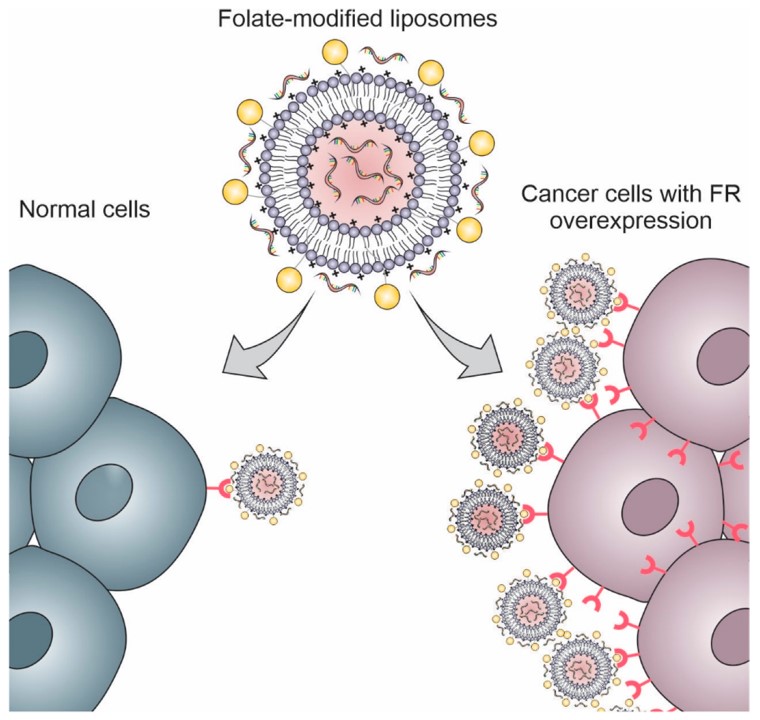Vitamin-modified Liposome Development Service
Tumor cells frequently upregulate the process of vitamin absorption as compared to normal cells, resulting in an overexpression of vitamin transport receptors on their surfaces. Creative Biolabs can help you achieve drugs delivery to tumors by modifying the surface of liposomes with various vitamins.
Vitamin-modified Liposome
Creative Biolabs can provide you with customized services for vitamin-modified liposomes, including folate, TPGS, riboflavin, biotin, and more.
Folate (also known as vitamin B9) is essential for cell division and development. It is transported into cells through folate receptors (FR), which are 100-300 times more expressed in tumor cells than in normal cells. As the most often employed vitamin ligand in liposomes, folate establishes the groundwork for the usage of other vitamins to functionalize liposomes.
 Fig.1 Folate-modified liposomes can target tumor cells overexpressing FR.1,3
Fig.1 Folate-modified liposomes can target tumor cells overexpressing FR.1,3
D-α tocopheryl polyethylene glycol succinate (TPGS) is synthesized by esterifying vitamin E succinate with a PEG chain. TPGS-modified liposomes provide the following benefits:
Improved cellular uptake, which increases drugs bioavailability.
Avoiding opsonization and phagocytosis, which increases circulation half-life.
TPGS possesses antioxidant properties, which limit oxidative destruction of drugs within liposomes during storage, hence increasing stability.
TPGS inhibits P-glycoprotein, which significantly reduces drug efflux from tumor cells.
 Fig.2 Schematic representation of TPGS and TPGS -modified liposome.2,4
Fig.2 Schematic representation of TPGS and TPGS -modified liposome.2,4
-
Riboflavin-modified liposome
Energy metabolism in aerobic cells is aided by vitamin B2, often referred to as riboflavin. Riboflavin carrier protein (RCP) is an estrogen-induced protein that is overexpressed in breast, prostate, and hepatocellular tumors. Based on ligand-receptor interaction, riboflavin-modified liposomes provide targeted drug delivery to tumor cells.
Biotin, also known as vitamin H, has the advantages of easy modification, simple structure, small molecular weight, and high uptake by tumor cells. The multivitamin transporter (SMVT) is the main transporter protein for biotin and is overexpressed in various aggressive cancer cells, such as breast, ovarian, colon, and lung cancer.
In order to meet your needs for targeted drug delivery, Creative Biolabs can provide customized liposome development services using a variety of vitamins as ligands, including nicotinamide, vitamin A, pyridoxal phosphate, etc.
Why Choose Us?
-
Client-centric customization
-
Competitive pricing
-
Quality assurance
-
Timely delivery
-
Non-disclosure agreement
-
Secure data management
Creative Biolabs, with its cutting-edge experience in liposome development, can supply you with customized products that meet your specific needs and research objectives. Our vitamin-modified liposomes, including folate, TPGS, riboflavin, biotin, nicotinamide, and more, are meticulously crafted to enhance the precision and efficacy of your drug delivery applications. From professional formulation design to meticulous quality control, our vitamin-modified liposomes are engineered to elevate your research to new heights.
References
-
Luiz, Marcela Tavares, et al. "Targeted liposomes: A nonviral gene delivery system for cancer therapy." Pharmaceutics 14.4 (2022): 821.
-
Farooq, Muhammad Asim, and Natalie L. Trevaskis. "TPGS decorated liposomes as multifunctional nano-delivery systems." Pharmaceutical Research 40.1 (2023): 245-263.
-
under Open Access license CC BY 4.0, without modification.
-
under Open Access license CC BY 4.0, the image is a composite of figure 1 and figure 2.

For Research Use Only. Not For Clinical Use

 Fig.1 Folate-modified liposomes can target tumor cells overexpressing FR.1,3
Fig.1 Folate-modified liposomes can target tumor cells overexpressing FR.1,3
 Fig.2 Schematic representation of TPGS and TPGS -modified liposome.2,4
Fig.2 Schematic representation of TPGS and TPGS -modified liposome.2,4
 For Research Use Only. Not For Clinical Use
For Research Use Only. Not For Clinical Use


